Eamonn McCabe's Favourite Images
Muhammad Ali in Miami
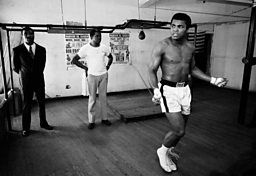
Chris Smith, b. 1937. Smith was a sports photographer at the Observer from 1970-1976 before joining The Sunday Times where he stayed for 30 years. He covered the whole of Muhammad Ali's career. He's known for bringing a new perspective to sports photography thanks to his ability to combine both action and feature ideas in his work. He was Sports Photographer of the Year four times and has many other accolades to his name.
The Guvnors

Don McCullin CBE, b. 1935. McCullin is an internationally acclaimed British war photographer known for covering conflicts in the Congo, Biafra, Vietnam, Cambodia, Northern Ireland and Darfur. The Guvnors was his first published image. It formed part of a half-page article in the Observer on 15 February 1959 reflecting the local gang scene in North London.
The Kray Twins
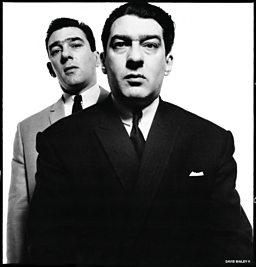
David Bailey CBE, b. 1938. Bailey shot to fame in the 1960s as a photographer for Vogue Magazine, with his images of Jean Shrimpton, The Beatles , The Rolling Stones and Michael Caine. He also photographed the Kray brothers whom he'd known since his youth. Since then, he's produced more than 20 books, directed films, arranged photographic shows, made commercials and held solo exhibitions of his paintings.
Anthony Blunt

Jane Bown CBE, b. 1925. Bown was part of The Observer's DNA for more than 50 years. She is known for her unpretentious portraits using natural light - from Bertrand Russell to Björk, and every Prime Minister since Harold Macmillan. Her photographs of the eccentric British are also popular - a Bishop on the way to the loo at the Synod and leather-clad bikers on top of Beachy Head. The portrait of Anthony Blunt was taken 11 years before he was exposed as a spy for Russia.
Automobile Delage, Circuit de Dieppe, 26 June 1912

Jacques-Henri Lartigue, b. 1894. Lartigue was a prolific, exuberant amateur photographer whose work and personal albums span most of the twentieth century. He was a visual athlete with the unbridled enthusiasm of a child, specialising in capturing fleeting moments of joy. He remained largely unnoticed until he was 69, when The Museum of Modern Art in New York exhibited some of his work. He's since been regarded as one of the masters of photography.
Assembled Panorama of the World Trade Center Site
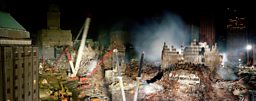
Joel Meyerowitz, b. 1938. Meyerowitz was an early advocate of colour photography in the 1960s. As well as his New York street photography, he is recognised for his work charting the transformation of Ground Zero after the attacks on the World Trade Center in 2001. He was the only photographer to have continued access to the site which was regarded as a crime scene and known as The Forbidden City.
Le Nu Provencal, Gordes
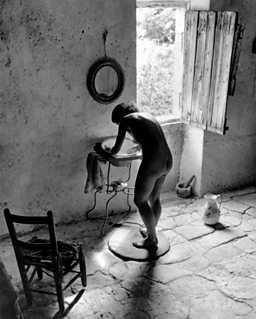
Willy Ronis, b. 1910. Unlike his contemporaries, Henri Cartier-Bresson and Robert Doisneau, Ronis spent most of his life in France. His candid images of everyday life in post-war Paris managed to combine his political view and his poetic eye. He said "It is the typical that interests me, not the scoop." As well as his photo reportage, he is known for his nudes, the most recent of which was taken in 2001.
Soldiers of the Sky

Nickolas Muray, b. 1892. Muray emigrated from Hungary to New York when he was 21. He was an early adopter of the complicated carbro process, which relied on chemicals, not light to build up layers of pigment. He is considered one of the masters of the process and his 10,000 portraits and food images still retain their initial saturation and vibrancy. His best-known images are his 1938 portrait of painter Frida Kahlo, made at the height of their affair, and The Soldiers of the Sky (1940), a photo montage of two images.
Curraghs, Dingle
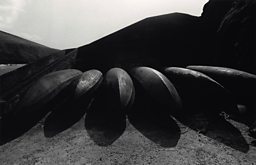
Michael Kenna, b. 1953. The British photographer Michael Kenna works exclusively in black and white. Influenced by Bill Brandt's use of shadow, he specialises in creating an ethereal light which blurs our perception of day- and night-time images. His main interest is exploring the relationship between the landscape and structures that we place in it.
Pembrokeshire
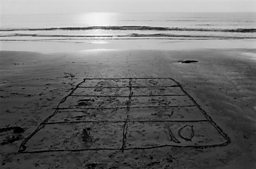
Raymond Moore, b. 1920. Moore was part of the generation of cult British photographers who emerged in the 1970s along with Martin Parr and Chris Killip. He was a key player in the development of photographic practice in the UK, focusing on the commonplace and the everyday and infusing them with a sense of timelessness. He was also considered one of the great teachers of photography.




